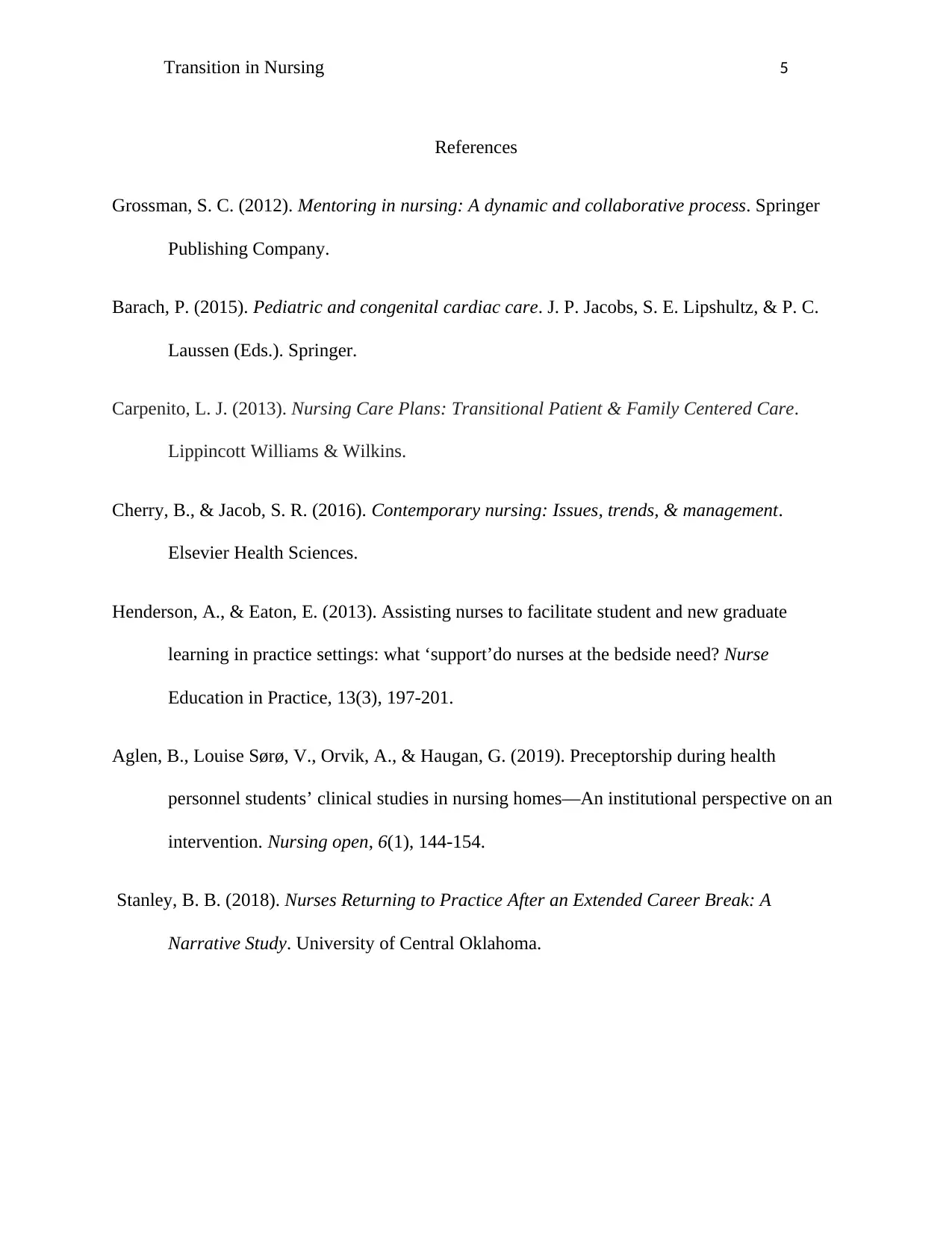Contemporary Transitional Factors in Nursing: Preceptor and Mentorship
VerifiedAdded on 2022/12/26
|5
|964
|33
Essay
AI Summary
This essay examines the contemporary transitional factors in nursing, focusing on the roles of preceptors and mentors. It defines transition as a shift in responsibilities and discusses challenges like anxiety and burnout. The essay explores the reasons behind these transitions, including staff development and shortages, and analyzes how preceptors and mentors help nurses adapt by introducing new procedures and providing support. It further discusses the impact of these factors on nursing and patient care, highlighting that poor coping with transition can lead to negative patient outcomes. The essay concludes by suggesting that healthcare professionals should be trained to cope with these factors and seek support from colleagues and mentors to ensure successful transitions, ultimately leading to better patient outcomes. The essay is well-supported by academic references.

Running head: TRANSITION IN NURSING 1
Transition in Nursing
Institution
Student
Date
Transition in Nursing
Institution
Student
Date
Paraphrase This Document
Need a fresh take? Get an instant paraphrase of this document with our AI Paraphraser

Transition in Nursing 2
Transition in Nursing
The Role of Preceptor and Mentorship
WHAT: Describe the contemporary transitional factor with evidence
Transition refers to the process of shifting from one state to another one that is often associated
with considerable changes in responsibilities, goals, and roles. Studies have proven that during
the process of transition, various challenges such as panic, fear, burnout, and anxiety undermine
and endanger nurses’ mental and physical health. Whenever a physician or a nurse is transferred
to a new healthcare setting, he/she is paired with a preceptor for a given period of time (normally
called orientation). During this time, the preceptor helps the nurse cope with the aforementioned
challenges associated with the contemporary transitional factor. The preceptor in this case takes
the role of an educator, role model, confidant, and friend. Besides, they are assigned some
mentors who support and guide them further (Grossman, 2012).
WHY: Describe, discuss and analyze why the contemporary transitional factor occurs with
evidence.
Contemporary transitional factor occurs due to various reasons such as staff training and
development, nursing staff shortage, and professional commitment and accountability. Nurses
can transfer in search of adequate training and preparation in order to improve their skills and
make them more robust against the strains and stresses they face (Cherry, & Jacob, 2016).
Despite the special various reasons of transitioning, the preceptor orients them. He introduces
them to new procedures, policies, and the social milieu of the new hospital and makes sure that
the skills they get are competent, safe, and helpful. They are also paired with mentors who
Transition in Nursing
The Role of Preceptor and Mentorship
WHAT: Describe the contemporary transitional factor with evidence
Transition refers to the process of shifting from one state to another one that is often associated
with considerable changes in responsibilities, goals, and roles. Studies have proven that during
the process of transition, various challenges such as panic, fear, burnout, and anxiety undermine
and endanger nurses’ mental and physical health. Whenever a physician or a nurse is transferred
to a new healthcare setting, he/she is paired with a preceptor for a given period of time (normally
called orientation). During this time, the preceptor helps the nurse cope with the aforementioned
challenges associated with the contemporary transitional factor. The preceptor in this case takes
the role of an educator, role model, confidant, and friend. Besides, they are assigned some
mentors who support and guide them further (Grossman, 2012).
WHY: Describe, discuss and analyze why the contemporary transitional factor occurs with
evidence.
Contemporary transitional factor occurs due to various reasons such as staff training and
development, nursing staff shortage, and professional commitment and accountability. Nurses
can transfer in search of adequate training and preparation in order to improve their skills and
make them more robust against the strains and stresses they face (Cherry, & Jacob, 2016).
Despite the special various reasons of transitioning, the preceptor orients them. He introduces
them to new procedures, policies, and the social milieu of the new hospital and makes sure that
the skills they get are competent, safe, and helpful. They are also paired with mentors who

Transition in Nursing 3
basically conduct the role of mentoring them. The primary purpose of mentors is to guide,
support, and encourage them in their new positions so that they can continue developing
personally and professionally (Henderson, & Eaton, 2013).
HOW: Discuss and analyze how the contemporary transitional factor affects nursing and
quality patient care with evidence
As pointed out earlier, nurses encounter various problems such as panic, poor job satisfaction,
overdependence, inability to meet professional responsibilities, fear, burnout, and anxiety as a
result of the contemporary transitional factor (Carpenito, 2013). Since there is a direct
relationship between quality of care they provide and their quality of their working life, the
ultimate outcome of poor coping with transition is negative patient outcome and inferior quality
of patient care. However, preceptors and mentors help nurses cope with various factors which
can lead to low quality patient care. Preceptors observe and model nurses with new skills and
periodically evaluate how those skills are helping them deliver quality services. For example, a
preceptor may explain to a newly transferred nurse how a certain medication procedure is
followed to get splendid results. Mentors on the other hand, act as leaders and lead the nurses in
their day-to-day operations. They couch, advise, and encourage them on how to render good
healthcare services (Aglen, Louise Sørø, Orvik, & Haugan, 2019).
Discuss and analyze how the contemporary transitional factor should be addressed to
provide outcomes for nursing and patient care.
Healthcare gives should be adequately trained on how to cope with the problems associated with
contemporary transitional factor such as stress and anxiety. With proper training, transition
basically conduct the role of mentoring them. The primary purpose of mentors is to guide,
support, and encourage them in their new positions so that they can continue developing
personally and professionally (Henderson, & Eaton, 2013).
HOW: Discuss and analyze how the contemporary transitional factor affects nursing and
quality patient care with evidence
As pointed out earlier, nurses encounter various problems such as panic, poor job satisfaction,
overdependence, inability to meet professional responsibilities, fear, burnout, and anxiety as a
result of the contemporary transitional factor (Carpenito, 2013). Since there is a direct
relationship between quality of care they provide and their quality of their working life, the
ultimate outcome of poor coping with transition is negative patient outcome and inferior quality
of patient care. However, preceptors and mentors help nurses cope with various factors which
can lead to low quality patient care. Preceptors observe and model nurses with new skills and
periodically evaluate how those skills are helping them deliver quality services. For example, a
preceptor may explain to a newly transferred nurse how a certain medication procedure is
followed to get splendid results. Mentors on the other hand, act as leaders and lead the nurses in
their day-to-day operations. They couch, advise, and encourage them on how to render good
healthcare services (Aglen, Louise Sørø, Orvik, & Haugan, 2019).
Discuss and analyze how the contemporary transitional factor should be addressed to
provide outcomes for nursing and patient care.
Healthcare gives should be adequately trained on how to cope with the problems associated with
contemporary transitional factor such as stress and anxiety. With proper training, transition
⊘ This is a preview!⊘
Do you want full access?
Subscribe today to unlock all pages.

Trusted by 1+ million students worldwide

Transition in Nursing 4
cannot affect nurses’ performance negatively or undermine their effectiveness (Barach, 2015).
In addition, they should be encouraged to seek for support from new colleagues or their superiors
on how they can cope successfully with various problems they might experience. They should
seek help from preceptors and their mentors whenever they are need of their help. This implies
that every health center should be well equipped with qualified personnel to act as preceptors and
mentors. Newly transitioned nurses will be educated, advised, couched, and encouraged by these
preceptors and mentors (Stanley, 2018).
cannot affect nurses’ performance negatively or undermine their effectiveness (Barach, 2015).
In addition, they should be encouraged to seek for support from new colleagues or their superiors
on how they can cope successfully with various problems they might experience. They should
seek help from preceptors and their mentors whenever they are need of their help. This implies
that every health center should be well equipped with qualified personnel to act as preceptors and
mentors. Newly transitioned nurses will be educated, advised, couched, and encouraged by these
preceptors and mentors (Stanley, 2018).
Paraphrase This Document
Need a fresh take? Get an instant paraphrase of this document with our AI Paraphraser

Transition in Nursing 5
References
Grossman, S. C. (2012). Mentoring in nursing: A dynamic and collaborative process. Springer
Publishing Company.
Barach, P. (2015). Pediatric and congenital cardiac care. J. P. Jacobs, S. E. Lipshultz, & P. C.
Laussen (Eds.). Springer.
Carpenito, L. J. (2013). Nursing Care Plans: Transitional Patient & Family Centered Care.
Lippincott Williams & Wilkins.
Cherry, B., & Jacob, S. R. (2016). Contemporary nursing: Issues, trends, & management.
Elsevier Health Sciences.
Henderson, A., & Eaton, E. (2013). Assisting nurses to facilitate student and new graduate
learning in practice settings: what ‘support’do nurses at the bedside need? Nurse
Education in Practice, 13(3), 197-201.
Aglen, B., Louise Sørø, V., Orvik, A., & Haugan, G. (2019). Preceptorship during health
personnel students’ clinical studies in nursing homes—An institutional perspective on an
intervention. Nursing open, 6(1), 144-154.
Stanley, B. B. (2018). Nurses Returning to Practice After an Extended Career Break: A
Narrative Study. University of Central Oklahoma.
References
Grossman, S. C. (2012). Mentoring in nursing: A dynamic and collaborative process. Springer
Publishing Company.
Barach, P. (2015). Pediatric and congenital cardiac care. J. P. Jacobs, S. E. Lipshultz, & P. C.
Laussen (Eds.). Springer.
Carpenito, L. J. (2013). Nursing Care Plans: Transitional Patient & Family Centered Care.
Lippincott Williams & Wilkins.
Cherry, B., & Jacob, S. R. (2016). Contemporary nursing: Issues, trends, & management.
Elsevier Health Sciences.
Henderson, A., & Eaton, E. (2013). Assisting nurses to facilitate student and new graduate
learning in practice settings: what ‘support’do nurses at the bedside need? Nurse
Education in Practice, 13(3), 197-201.
Aglen, B., Louise Sørø, V., Orvik, A., & Haugan, G. (2019). Preceptorship during health
personnel students’ clinical studies in nursing homes—An institutional perspective on an
intervention. Nursing open, 6(1), 144-154.
Stanley, B. B. (2018). Nurses Returning to Practice After an Extended Career Break: A
Narrative Study. University of Central Oklahoma.
1 out of 5
Related Documents
Your All-in-One AI-Powered Toolkit for Academic Success.
+13062052269
info@desklib.com
Available 24*7 on WhatsApp / Email
![[object Object]](/_next/static/media/star-bottom.7253800d.svg)
Unlock your academic potential
Copyright © 2020–2025 A2Z Services. All Rights Reserved. Developed and managed by ZUCOL.





